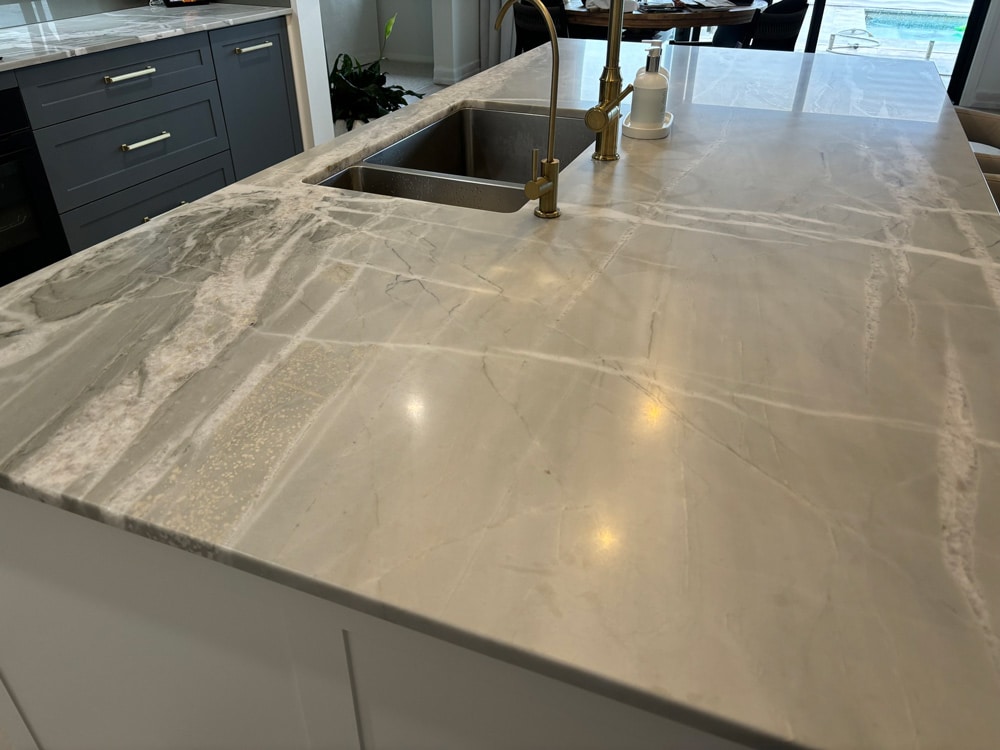When choosing stone for your kitchen, bathroom, or commercial space, one factor often overlooked is the size of the stone slab itself. The stone slab size is a crucial element that influences the aesthetics, functionality, and installation process of your project. Whether you are designing a kitchen benchtop, bathroom vanity, or feature wall, understanding how slab size impacts design can help you make informed decisions and achieve a seamless finish. Let’s get into the details.
Why Slab Size Matters
Stone slabs come in a variety of sizes, and the dimensions you choose can significantly affect your project in several ways:
Aesthetic Appeal
The size of the stone slab plays a vital role in the overall visual impact of a space. Larger slabs offer a clean, uninterrupted look with fewer seams or joints, creating a luxurious and cohesive appearance. This is particularly important for areas like kitchen islands or feature walls, where continuous veining or patterns can enhance the elegance of the space.
On the other hand, smaller slabs may require additional joins, which can disrupt the natural flow of the stone’s design. While skilled stonemasons can expertly match patterns across seams, larger slabs often provide a more visually striking result.
Functionality
Choosing the right stone slab size is not just about appearance—it’s also about practicality. The size should suit the dimensions of the space where the stone will be installed. For example:
- Kitchens: Benchtops and islands benefit from larger slabs to reduce joins and create a seamless surface for food preparation and entertaining.
- Bathrooms: Vanities, splashbacks, and shower walls often require precision cuts, and the right slab size can minimise waste while ensuring proper coverage.
- Commercial Spaces: Larger stone slabs can make a bold statement in lobbies or reception areas, while smaller slabs may suit areas with more intricate designs.
Selecting the correct size also reduces the need for excessive cutting or modification, improving the durability and integrity of the stone.
Installation Considerations
The size of the stone slab directly impacts the installation process. Larger slabs can be heavy and challenging to manoeuvre, requiring specialised equipment and additional labour. Smaller slabs, while easier to handle, may increase the complexity of aligning patterns across seams.
Benefits of Consulting a Stonemason
While it might be tempting to choose stone slabs based purely on aesthetics, working with a professional stonemason can save time, money, and frustration. Here’s why consulting a stonemason is essential:
- Expert Advice: A stonemason can assess your space and recommend the best slab size for your needs, considering factors like layout, usage, and stone type.
- Precision Cutting: Professionals use advanced tools to cut and fit slabs with precision, ensuring minimal waste and perfect finishes.
- Seam Management: Skilled stonemasons can expertly match seams and patterns, maintaining the natural beauty of the stone.
- Handling & Installation: Larger slabs require careful handling to avoid cracks or damage. A stonemason has the expertise to transport and install the stone safely.
Find the Perfect Slab Size for Your Project
Choosing the right stone slab size is a critical decision that impacts both the beauty and practicality of your space. From reducing joins to enhancing natural patterns, the right slab size can elevate your design. Don’t leave it to chance—contact us at Vivid Stoneworks. Our stonemasons in Newcastle are here to offer advice and assistance with your stone project.

